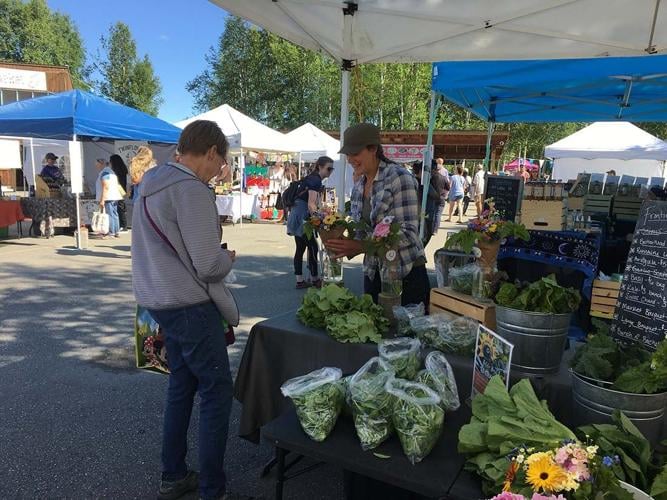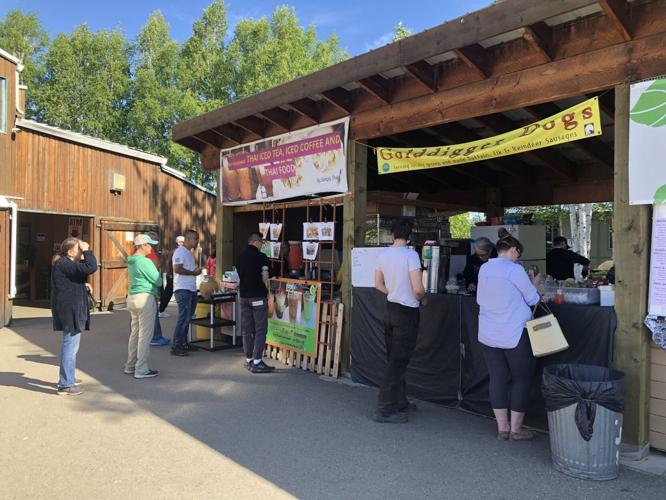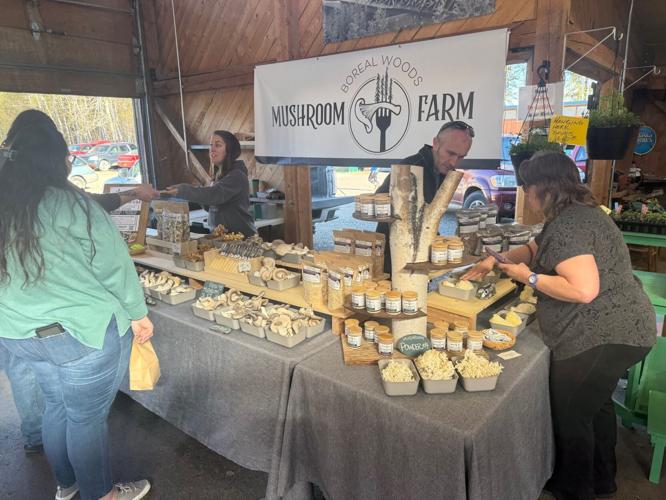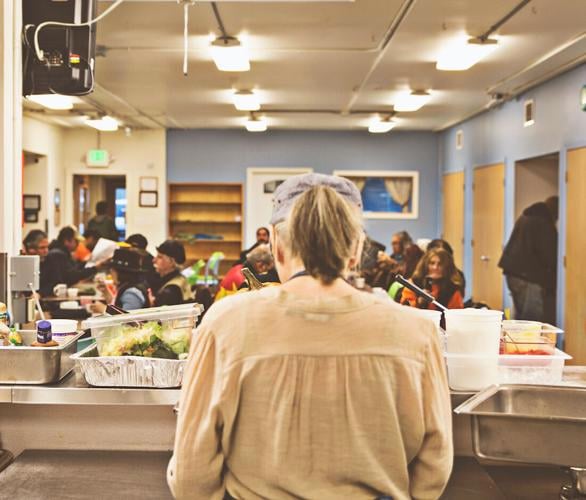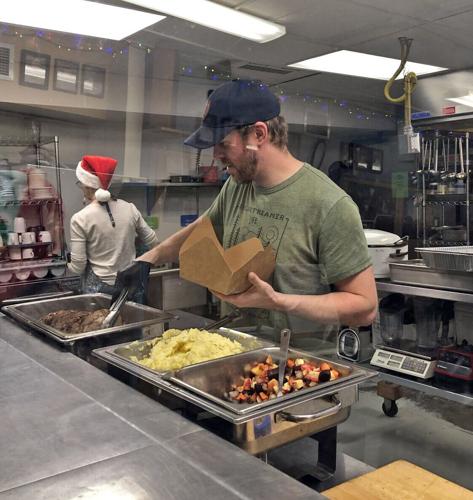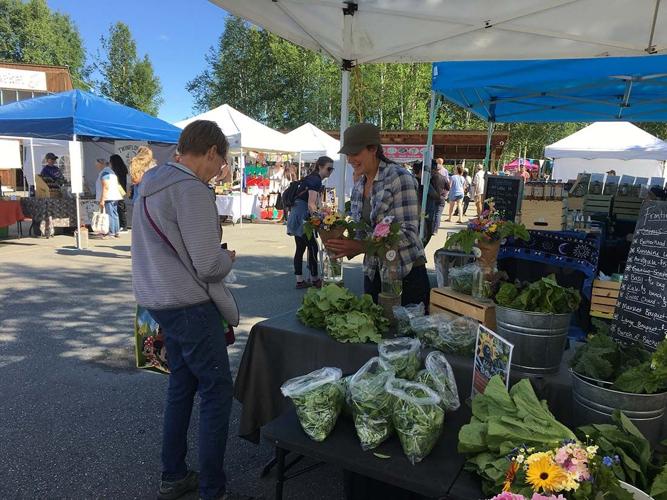When Brad St. Pierre brought fresh produce to Stone Soup Cafe, Fairbanks’ downtown soup kitchen run by Bread Line, on Thursdays in the summer, it was one of the best days of his week.
“It made me feel like the labor and passion I have for my work has purpose,” he said.
Funding from the Local Food Purchase Assistance Cooperative Agreement Program (LFPA) allowed St. Pierre, owner of Goosefoot Farm, to give ten Community Supported Agriculture shares to Bread Line in Fairbanks for 13 weeks. He received approximately $4,750 per year through LFPA to give produce to the organization.
The LFPA provided states funding to purchase food produced in the state “to help support local, regional and underserved producers.”
“The purpose of this program is to maintain and improve food and agricultural supply chain resiliency,” the United States Department of Agriculture (USDA) stated.
The USDA has now cut nearly $800,000 in Alaska LFPA funding for 2025.
LFPA cuts are a hit to Goosefoot Farm’s finances and a hit to the farm’s mission. “We want to have food accessible, and we want farmers to be paid for the right value and work,” St. Pierre said. “It’s going to be a big hit. We’re scrambling.”
Previously obligated funds to the LFPA as well as the Local Food for Schools Cooperative Agreement Program (LFS) were released on March 7. The 2025 LFPA and LFS funding has been reallocated, including $765,450 in 2025 LFPA funding in Alaska. The Fairbanks North Star Borough School District does not receive funds from the LFS.
The Alaska Farmers Markets Association (AFMA) was one of the awardees that received approximately $250,000 from LFPA funding in 2023 and 2024. AFMA then reallocated to 39 farmers with the help of seven farmers markets, including the Tanana Valley Farmers Market and Calypso Farm and Ecology Center.
Alaska Farmers Market Association
AFMA Executive Director Claire Marshalek said that the program rounded out the income for small farmers while contributing to anti-hunger efforts.
“Our goal specifically was to uplift and support new and beginning farmers and farmers who were just having a challenging selling season,” she said. “This is a perfect way to make sure our farmers are compensated for everything they grow.”
The grant required awardees to deliver food to anti-hunger organizations, such as food banks, soup kitchens and elder outreach programs.
The Division of Agriculture emailed Marshalek on March 7 informing her that the remainder of the projects will be cancelled. “I just really felt for the farmers,” she said.
The program that allows markets, including the Tanana Valley Farmers Market and Southside Community Market, to double Supplemental Nutrition Assistance Program dollars was not impacted by these cuts.
The farmers
Big Spruce Garden, Frontieress Farm, Risse GreenHouse, Bender Mountain, Off Beet Farm and Ann’s Greenhouse also received funding from the LFPA through the Tanana Valley Farmers Market.
Megan Schulze, owner of Frontieress Farm, said that the program allowed her farm to give any excess vegetables in the fields or that didn’t sell at market to the food bank and compensated her for her labor.
“This was produce that was either going to get donated or it was just going to get composted so just being able to have that extra income was beneficial for my farm,” she said.
Schulze received about $2,000 from LFPA in 2024 and was expecting funding this year. She planned on planting leafy greens in a new field to put more organic matter back into the soil.
“I was planning on those leafy greens going to the food bank, but I’ve had to switch that up to go into a CSA,” she said.
Since Shulze will not receive that funding, she pivoted her farm plan and is selling CSA shares instead.
“It might seem just like a drop in the bucket, but we’re working hard for any drop,” she said.
Shulze said she was disappointed to learn about the LFPA funding cuts since the program supported small businesses and helped people with less access to produce.
“It was benefitting farmers and community members,” she said.
The LFPA program was first funded by the American Rescue Plan in 2021. The program provided $900 million in 2023 and 2024 to source food from local producers to food banks, food pantries and communities.
The Alaska Division of Agriculture signed the agreement in July 2022. The goal of the project was to provide an income source for Alaska farmers and provide local food to food insecure Alaskans.
Bread Line impacted
Bread Line Executive Director Hannah Hill said the community’s need has increased. Bread Line served 59,000 meals in 2023 and 66,000 meals in 2024 at Stone Soup Cafe.
Goosefoot Farm donated more than 1,000 pounds of local produce to Bread Line in 2023 and 2024.
“Those donations have shaped the way that our summer food service programs look,” Hill said. “It really elevated our capacity, both in the amount that we have been able to serve and in the quality of food that we can consistently provide.”
Hill said that their professional chefs utilize food that might otherwise be thrown away to make good meals.
“It is just hard to overstate how important or how helpful this has been to us,” Hill said. “When we get resources like local food that means that we are able to give people more than scraps.”
Hill said that the cuts to the grant take money out of the local economy and take food away from vulnerable Alaskans.
“It’s bananas to me that we would just cut the feet off local foods being made available and increase our dependence on vulnerable supply chains,” they said.
Farmers markets, food bank and elder outreach
St. Pierre is also the executive director of the Tanana Valley Farmers Market and said that the market distributed more than $45,000 to farmers in 2023 and 2024.
Farmers were told that they could depend on LFPA funding in 2025, and many have already purchased seeds and made plans because they expected that funding.
St. Pierre said that the biggest barrier to food security in the Interior is the lack of producers. LFPA reduced the risk of farming for newer producers because it meant that farmers would be compensated for food that did not sell at the market.
“We need these farmers and all these programs ensure that we continue to have food producers,” he said.
LFPA benefitted farmers as well as people struggling with food security in Fairbanks.
“It’s a lot of food that isn’t going to be hitting the mouths that need the most,” he said.
The Fairbanks Community Food Bank has served nearly 800,000 meals of almost 1 million pounds of food in the last 12 months, according to Samantha Kirstein, its community development director.
Kirstein said that most of the food comes through donations from local grocery stores and individual donors. The Food is Medicine program provides six pounds of fresh food per day to about 800 patients in the Interior.
“We’re truly a community food bank supported by our community,” Kirstein said. “Government funds come and go — it is a fact that we need to be supported by our community.”
Calypso Farm and Ecology Center operates the Southside Community Farmers Market on Tuesdays in the summer months. Calypso Farm partnered with Bread Line to offer a free meal for about 300 people weekly at the market.
Susan Willsrud, farm director at Calypso Farm and Ecology Center, said that the program supported small scale farmers, boosted the local economy and got quality food to people in need.
Through the LFPA, Calypso Farm received $16,000 in 2024 to purchase food to serve at the meal and disperse funds to 10 vendors at the market. Calypso Farm also received an exemption to directly distribute food to low income seniors.
“I think it was an amazing program because it was one of the first times I’ve seen a partnership in the sense of providing food relief for a community and also supporting the farming community, which is critical for food security, for building healthy farming communities,” she said.
A USDA spokesperson said by email that the end of pandemic-era programs like the LFPA and LFS marks “a return to long-term, fiscally responsible initiatives.”
“With 16 robust nutrition programs in place, USDA remains focused on its core mission: strengthening food security, supporting agricultural markets, and ensuring access to nutritious food,” the spokesperson stated. “Unlike the Biden Administration, which funneled billions in CCC funds into short-term programs with no plan for longevity, USDA is prioritizing stable, proven solutions that deliver lasting impact. The Covid era is over — USDA’s approach to nutrition programs will reflect that reality moving forward.”
The Alaska Division of Agriculture did not respond to the News-Miner’s request for comment.
Community resilience
Accessibility and inclusivity are central to Calypso Farm’s mission, Willsrud said. “One of our local goals is that local foods would be available and accessible while also supporting farmers.”
Willsrud said that Calypso Farm plans to continue hosting the weekly meals through fundraising, but cannot continue to directly purchase produce for the meals and for low income seniors without LFPA. She added that Calypso Farm is prepared to donate half to three-quarters of the food for community meals through food grown at Calypso and through the Community Roots program at Hunter Elementary School.
“Programs like these are not a waste of funds,” Willsrud said. “It’s providing community need in supporting people who are struggling in our communities. It’s a really simple way to support the local food system and farmers.”
Similarly, St. Pierre is searching for local residents that would purchase a Goosfoot Farm CSA for donation to Stone Soup. If he can’t get enough donations, he plans to sell shares to local families to make up the difference.
“We will find a way to continue doing our work,” Hill, Bread Line executive director, said. “We’re going to figure it out because we have to.”

